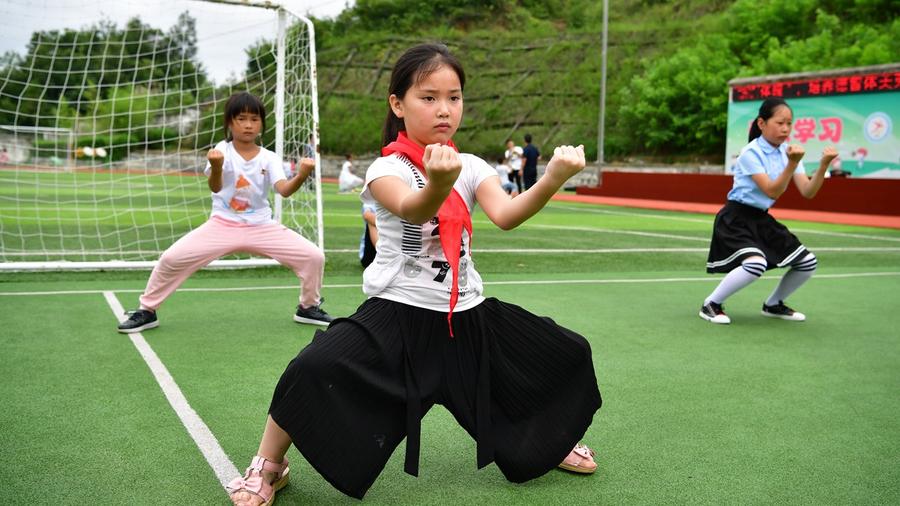 Students at a primary school in Pingli county, Shaanxi province, practice wushu during the summer vacation. (SHAO RUI / XINHUA)
Students at a primary school in Pingli county, Shaanxi province, practice wushu during the summer vacation. (SHAO RUI / XINHUA)
YINCHUAN-Upon the signal of the judge, a girl dressed in black with a broadsword in her hand suddenly appeared, changing her movements quickly with the dazzling glint of the sword, which emitted a soft whistle as it sliced through the air.
Zhao Yan, 17, won two gold medals in long boxing and blade play at a regional martial arts championship for teenagers held recently in Ningxia Hui autonomous region, Northwest China.
Chinese martial arts, also known as kung fu or wushu, boasts a history of over 3,000 years, but used to be popular only among China's middle-aged and elderly population.
More teenagers are engaged in martial arts competitions nowadays, and their competitiveness is improving daily
Wang Liang, chief range officer, martial arts championship for teenagers in Ningxia
In recent years, however, it has increased in popularity among younger generations, thanks to a rise in competitions, access to free lessons during school holidays, and greater government support.
In January, the International Olympic Committee confirmed that wushu would make its debut as an official sport at the 2022 Dakar Youth Olympic Games.
"It's exciting news for martial arts lovers, because it's a good chance to raise awareness of this wonderful sport, and we hope it features at the summer Olympic Games one day," says Wang Liang, chief range officer of the Ningxia championship.
"More teenagers are engaged in martial arts competitions nowadays, and their competitiveness is improving daily," adds Wang.
In the Ningxia championship, the category for children aged between 7 and 12 years old accounted for 60 percent of all competitors. In another martial arts championship for people of all ages held in Ningxia in early August, junior competitors accounted for 90 percent of the 497 entrants.
Nowadays, in addition to senior citizens practicing tai chi, a slow-speed martial art, groups of teens can also be seen learning kung fu from young masters in Yinchuan, capital city of Ningxia.
Additionally, more girls are engaged in martial arts training, and female competitors for this year's Ningxia championships are up by 100 compared with last year, according to Xu Fuyu, deputy secretary general of the Ningxia Martial Arts Association.
Born in Yinchuan, at the age of 11, Zhao Yan was sent by her parents to Henan province, where there is a strong tradition of teaching kung fu. During her two years in Henan, she lived with other apprentices and learned to take care of herself.
"Every day of martial arts training was so fantastic that I even forgot to eat on several occasions," Zhao says, adding that practicing martial arts has endowed her with independence, confidence and optimism.
Nowadays, Zhao studies at a sports college in Ningxia majoring in martial arts, and her enthusiasm for this traditional Chinese sport makes every day's hard workout enjoyable.
"I will seize the moment and try my best in every event. My goal is to enter university with my talent in martial arts, and I'm confident in myself," says Zhao.
Being a referee for some 20 years, Wang has noticed some positive trends, including an increase in younger martial arts judges and coaches, and a rise in the standard of martial arts lessons. Facilities have also evolved, improving the safety and efficiency of matches.
"In recent years, the number of martial arts gyms has grown like mushrooms after the rain," Xu observes.
Thanks to the influence of Bruce Lee, kung fu films and other factors, over 120 million people across the world are engaged in martial arts, an ancient sport containing Chinese cultural connotations like virtue and ceremony that is of both ornamental and competitive value.


